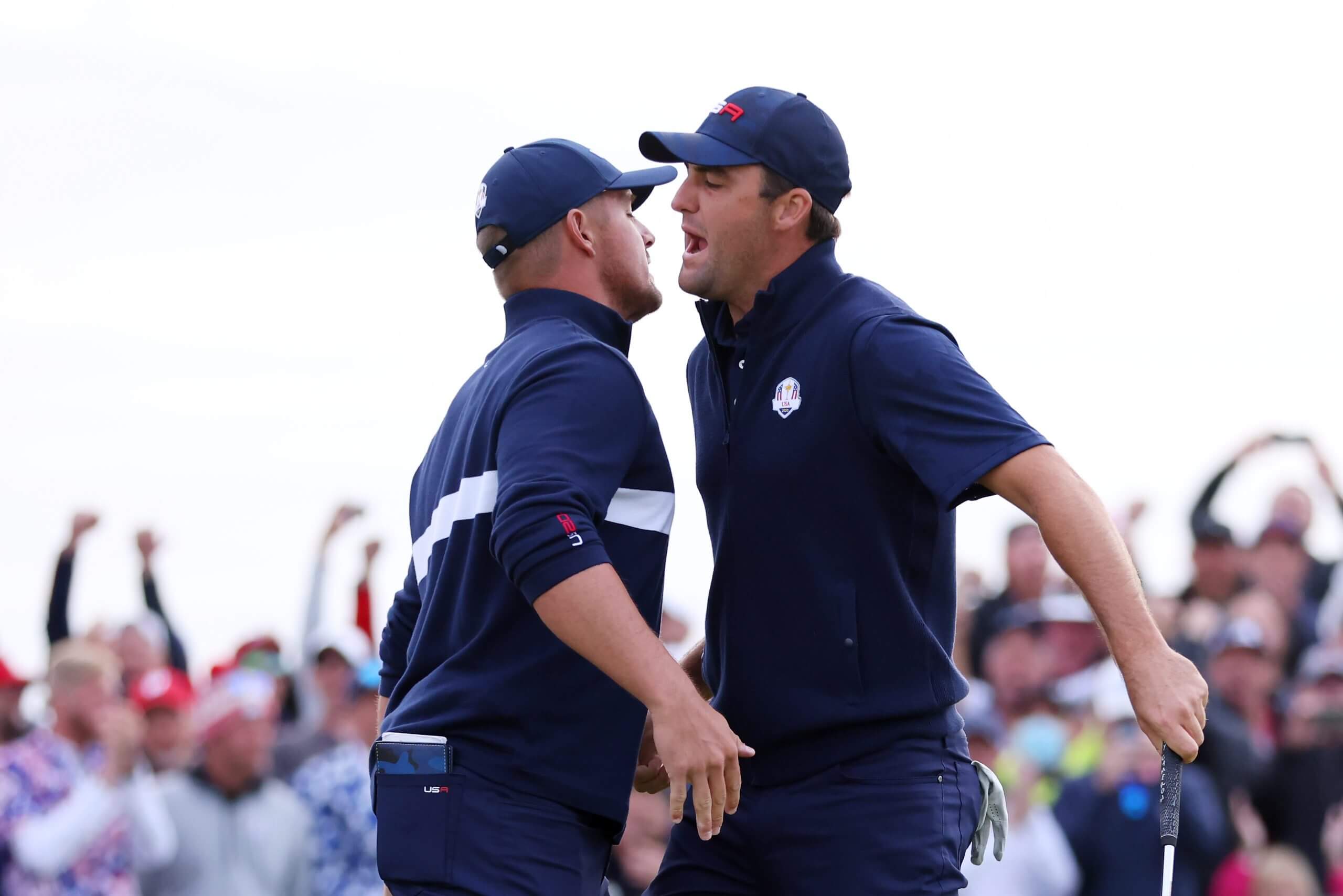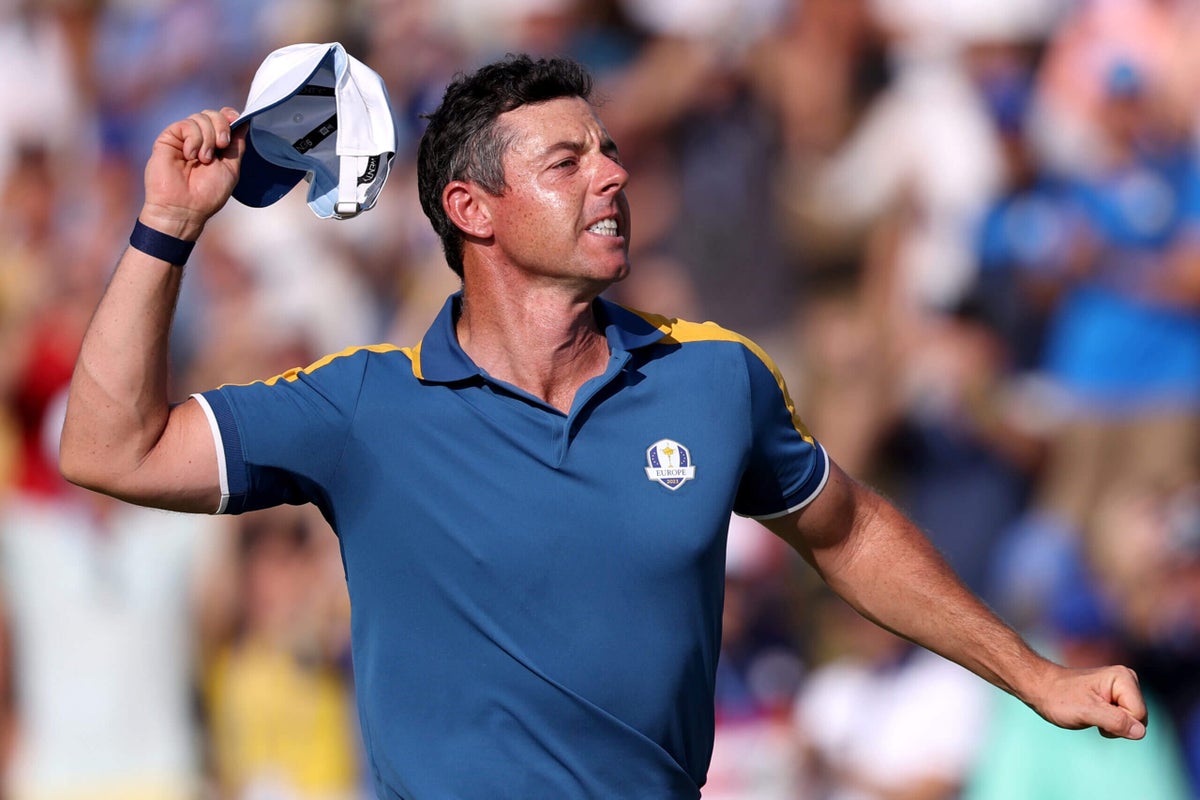For all the warranted excitement leading into the Ryder Cup, it’s worth noting that fans have been quietly deprived of a true nail-biter recently in golf’s greatest team competition.
In 2018, a dominant Saturday by the Europeans provided a four-point lead entering singles. Three years later at Whistling Straits, the Americans built a massive six-point advantage through four sessions. Two years ago in Rome, Europe led by five heading into singles play.
On paper, it looks like these two rosters should be neck-and-neck all weekend at Bethpage Black. I’d say we are long overdue for a classic.
Here are the top numbers and notes to know entering the 45th Ryder Cup.
1. Rory McIlroy has said that winning a Ryder Cup on foreign soil is one of the hardest things to achieve in golf. It’s not an exaggeration: since 1997, the number of players to complete the career grand slam (two, McIlroy and Tiger Woods) is equal to the number of times the away team has won the Ryder Cup (Europe in 2004 and 2012). The Americans haven’t won a Ryder Cup on European soil since 1993 at The Belfry. Half of the 2025 U.S. Ryder Cup roster were not yet born when that happened.
The instinctual reasoning for that is the home crowd generating a massive impact on player performance. The scoring by Ryder Cup rookies in recent years reflects some of that empirically – since 2008, rookies playing on home soil have averaged 0.59 points won per match and have a match win percentage of 50.4 percent. On foreign soil, those numbers are 0.46 points per match and 38.2 percent. Four years ago at Whistling Straits, Europe’s rookies had a dismal combined record of 1-8-2, while the Americans were 14-4-3.
2. Whatever impact the home side has on course setup is also a key factor. The foursomes format is where pairing strategy and lineup can have the greatest impact in team golf: captains and their support teams enter the match knowing who will hit certain shots based on player sequencing.
In a particular foursomes pairing, let’s say one player is an elite putter. If having that player tee off on the odd-numbered holes means he will have more birdie putt opportunities than if he was teeing off of the evens, the captain knows where he can gain a slight advantage based on order.
That’s just one of numerous hypothetical factors being weighed when it comes to generating lineups – but the results suggest it has had a seismic effect on the Ryder Cup in recent years. Over the last six Ryder Cups, the home team has a staggering +27 point differential in foursomes. The home team – whether it’s the Americans or Europeans – has won at least half a point in 38 of 48 alternate shot matches during that span.
And as foursomes has gone, so has the Ryder Cup. The side to win the foursomes battle has gone on to win the Cup five straight times and 11 of the last 14.
3. At the 2019 PGA Championship, Bethpage Black yielded the fourth-most approach shots from outside 200 yards among all courses that season. That more of those shots came on odd-numbered holes means nothing during stroke play, but in team golf, that can be a vital piece of information.
In foursomes, the player teeing off on the odd holes can expect to hit six approach shots of 170 to 220 yards. The first will come on hole three, a 210-yard (on the scorecard) par three, and hole four, a short par five where players went for the green in two 67 percent of the time during the 2019 PGA. A lead at that point in the match is extremely valuable from an historical perspective. Since 1985, a side leading 2-up after four holes in a Ryder Cup match go on to win 76 percent of the time.
Two more of those approach shots will come on consecutive holes down the stretch at 16 and 17. When comparing average proximity numbers from 175 to 225 yards this season, Europe has the three best among the 24 playing this week: Shane Lowry (32’2”), Viktor Hovland (32’4”) and Ludvig Åberg (33’7”).
4. Eleven players from the victorious European Ryder Cup team in 2023 return this week, the largest roster carryover from a previous team in Ryder Cup history. The previous mark was 10 members of the 1971 Great Britain and Ireland side competing for that flag in ’73 at Muirfield. The lone newcomer to the European team is Rasmus Højgaard, who replaces his brother Nicolai.
The European side brings significantly more past Ryder Cup experience to the table: McIlroy and Justin Rose alone have combined for more career matches played (59) than the entire American roster (56). However, the past point percentages for the rosters are nearly identical. The American roster has earned points in 53.6 percent of its previous Ryder Cup matches played. The Europeans? 53.5 percent.
The 2025 European team is the fifth since this Ryder Cup format was adopted in 1979 to feature one or no rookies. Each of the previous four either won or retained the Ryder Cup.
5. On paper, the two teams have assembled incredibly similar resumes around the world in 2025. The American roster has combined for 13 wins, Europe has 11. Europe has averaged 4.27 birdies or better per round worldwide as a roster this year – the Americans have made 4.25. Europe has finished in the top five in 19.2 percent of its official starts around the world. The Americans, 21.9 percent.
The Official World Golf Ranking was a defining performance metric and useful in comparing relative team strength for a generation. It’s not now. So we’ll compare Data Golf’s player rankings: Europe’s average is 22.7, its median 17.0. USA: average 12.6, median 10.5. For context, over the previous five Ryder Cups, the average differential in OWGR favored the Americans by 12.2 spots.

Scottie Scheffler (right) teamed up with Bryson DeChambeau at Whistling Straits for a 3 and 1 win against Tommy Fleetwood and Viktor Hovland. (Richard Heathcote / Getty Images)
6. No matter what player evaluation metric you use, Scottie Scheffler is ranked first. His one-shot win at the Procore Championship two weeks ago gave him six for the season after claiming seven in 2024. Since 1960, only three other players have won six or more PGA Tour titles in consecutive years – Woods, Arnold Palmer and Jack Nicklaus.
In his Ryder Cup debut in 2021 – which happened before he had won his first PGA Tour title at the 2022 WM Phoenix Open – Scheffler was a revelation, going unbeaten (2-0-1) and knocking off Jon Rahm in singles, 4 and 3. Rome was another story completely: no matches won (0-2-2) and a record 9 and 7 thrashing (with Brooks Koepka) from Hovland and Åberg in Saturday foursomes.
Woods was famously part of just one winning Ryder Cup team in his illustrious career. Incredibly, that is the only time the Americans had the reigning world No. 1 on their team and won the Ryder Cup – each of the last five times, including with Scheffler in 2023, Europe went on to win.
7. Meanwhile, the players currently ranked second, third and fourth in Data Golf’s metric are teeing it up for Europe this week: McIlroy, Tommy Fleetwood and Rahm.
McIlroy was Europe’s top point-earner in Rome (4-1-0), teaming with Fleetwood in two winning foursomes matches and splitting a pair in four-ball playing with Matt Fitzpatrick. The reigning Masters champion has a 7-7-0 career Ryder Cup match record on American soil, going 3-2-0 in 2012, the last European road win in the series.
With a record of 7-3-2, Fleetwood is trending towards winding up as an all-time European Ryder Cup great. Among all European Ryder Cup players with 10 or more matches played, Fleetwood has the second-best point percentage (66.7 percent) all-time. The only man he trails? His captain this week, Luke Donald (70.0 percent).
As for Rahm, he’s a perfect 4-0-0 in foursomes over his last two Ryder Cup appearances, teaming with countryman Sergio Garcia in 2021 and Tyrrell Hatton two years ago in Rome.
8. There’s an assumption that Xander Schauffele and Patrick Cantlay will reprise their familiar Cup combo this week, but should there be? Across their first three Ryder + Presidents Cups, they went 6-3-0 as a tandem. But in Rome, they lost their only two matches together, each 2 and 1 defeats.
Schauffele headed to Rome two years ago enjoying a terrific statistical season, on the precipice of his multi-major breakthrough the following year. An early season intercostal muscle injury this year, though, was followed by middling results. Schauffele is currently 85th on Tour in strokes gained off the tee in 2025 and 127th in strokes gained putting, a far cry from the elite play he’s shown throughout his career.
Cantlay isn’t quite the same, either. He has just nine top-10 finishes over the last two PGA Tour seasons, one fewer than he collected in 2023 alone (10). Whether or not Captain Bradley leans on the veteran pair this week is an interesting question.
9. The first tee shot of a Ryder Cup match isn’t just an adrenaline-pumping thrill ride – it’s also the start of one of the most important holes of the day. At Marco Simone two years ago, teams that won the first hole in foursomes and four-ball went unbeaten (5-0-2). In its last seven Ryder Cups on home soil, the Americans have gone on to win the match at a 61 percent rate after winning the first hole (25-12-4).
That early advantage trend persists virtually across the board in Ryder Cup history. Since 1979, the team that has won the opening match of the week has a record of 13-7. In that same time span, a team that wins the first match of a specific session has either won or tied said session at an 80 percent rate. Consider this, too: the Americans have not won the first match of a Ryder Cup four-ball session, then gone on to lose that session, since 2006.
10. The opening session Friday will be incredibly telling. Since 1975, the Americans have won the first session of the Ryder Cup on their home soil six times. They went on to win the Ryder Cup in each instance. Overall, seven of the last 10 teams to lead after the opening session of the Ryder Cup went on to win.
Friday foursomes begin at 7:10 a.m. ET.
(Photo of Rory McIlroy: Richard Heathcote / Getty Images)







